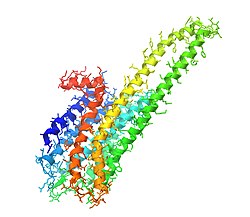The 5-HT2A receptor is a subtype of the 5-HT2 receptor that belongs to the serotonin receptor family and is a G protein-coupled receptor (GPCR).[4] The 5-HT2A receptor is a cell surface receptor,[5] but has several intracellular locations.[6]
Like all 5-HT2 receptors, the 5-HT2A receptor is Gq/G11-protein coupled. This is the main excitatory receptor subtype among the GPCRs for serotonin, although 5-HT2A may also have an inhibitory effect[7] on certain areas such as the visual cortex and the orbitofrontal cortex.[8] This receptor was first noted for its importance as a target of serotonergic psychedelic drugs such as LSD and psilocybin mushrooms. Later it came back to prominence because it was also found to be mediating, at least partly, the action of many antipsychotic drugs, especially atypical antipsychotics.
Downregulation of post-synaptic 5-HT2A receptor is an adaptive process provoked by chronic administration of selective serotonin reuptake inhibitors (SSRIs) and atypical antipsychotics. Suicidal and otherwise depressed patients have had more 5-HT2A receptors than normal patients. These findings suggest that post-synaptic 5-HT2A overdensity is involved in the pathogenesis of depression.[9]
Paradoxical down-regulation of 5-HT2A receptors can be observed with several 5-HT2A antagonists.[10] Thus, instead of tolerance, reverse-tolerance would be expected from 5-HT2A antagonists. However, there is at least one antagonist at this site which has been shown to up-regulate 5-HT2A receptors.[10][11] Additionally, a couple of other antagonists may have no effect on 5-HT2A receptor number.[12] Nevertheless, upregulation is the exception rather than the rule. Neither tolerance nor rebound is observed in humans with regard to the slow-wave sleep (SWS) promoting effects of 5-HT2A antagonists.[13]
- ^ a b c GRCh38: Ensembl release 89: ENSG00000102468 – Ensembl, May 2017
- ^ "Human PubMed Reference:". National Center for Biotechnology Information, U.S. National Library of Medicine.
- ^ "Mouse PubMed Reference:". National Center for Biotechnology Information, U.S. National Library of Medicine.
- ^ Cook EH, Fletcher KE, Wainwright M, Marks N, Yan SY, Leventhal BL (August 1994). "Primary structure of the human platelet serotonin 5-HT2A receptor: identify with frontal cortex serotonin 5-HT2A receptor". Journal of Neurochemistry. 63 (2): 465–469. doi:10.1046/j.1471-4159.1994.63020465.x. PMID 8035173. S2CID 40207336.
- ^ Kling A (2013). 5-HT2A: a serotonin receptor with a possible role in joint diseases (PDF). Umeå: Umeå Universitet. ISBN 978-91-7459-549-9.
- ^ Raote I (2007). "Serotonin 2A (5-HT2A) Receptor Function: Ligand-Dependent Mechanisms and Pathways". Ishier. Frontiers in Neuroscience. Press/Taylor & Francis. ISBN 9780849339776. PMID 21204452.
- ^ Martin P, Waters N, Schmidt CJ, Carlsson A, Carlsson ML (1998). "Rodent data and general hypothesis: antipsychotic action exerted through 5-HT2A receptor antagonism is dependent on increased serotonergic tone". Journal of Neural Transmission. 105 (4–5): 365–396. doi:10.1007/s007020050064. PMID 9720968. S2CID 20944107.
- ^ De Almeida RM, Rosa MM, Santos DM, Saft DM, Benini Q, Miczek KA (May 2006). "5-HT(1B) receptors, ventral orbitofrontal cortex, and aggressive behavior in mice". Psychopharmacology. 185 (4): 441–450. doi:10.1007/s00213-006-0333-3. PMID 16550387. S2CID 33274637.
- ^ Eison AS, Mullins UL (1996). "Regulation of central 5-HT2A receptors: a review of in vivo studies". Behavioural Brain Research. 73 (1–2): 177–181. doi:10.1016/0166-4328(96)00092-7. PMID 8788498. S2CID 4048975.
- ^ a b Yadav PN, Kroeze WK, Farrell MS, Roth BL (October 2011). "Antagonist functional selectivity: 5-HT2A serotonin receptor antagonists differentially regulate 5-HT2A receptor protein level in vivo". The Journal of Pharmacology and Experimental Therapeutics. 339 (1): 99–105. doi:10.1124/jpet.111.183780. PMC 3186284. PMID 21737536.
- ^ Rinaldi-Carmona M, Congy C, Simiand J, Oury-Donat F, Soubrie P, Breliere JC, et al. (January 1993). "Repeated administration of SR 46349B, a selective 5-hydroxytryptamine2 antagonist, up-regulates 5-hydroxytryptamine2 receptors in mouse brain". Molecular Pharmacology. 43 (1): 84–89. PMID 8423772.
- ^ Gray JA, Roth BL (November 2001). "Paradoxical trafficking and regulation of 5-HT(2A) receptors by agonists and antagonists". Brain Research Bulletin. 56 (5): 441–451. doi:10.1016/s0361-9230(01)00623-2. PMID 11750789. S2CID 271925.
- ^ Vanover KE, Davis RE (28 July 2010). "Role of 5-HT2A receptor antagonists in the treatment of insomnia". Nature and Science of Sleep. 2: 139–150. doi:10.2147/nss.s6849. PMC 3630942. PMID 23616706.




